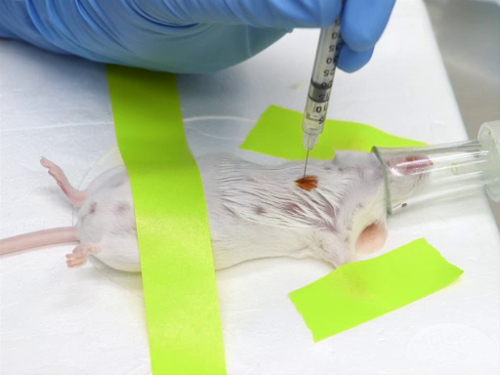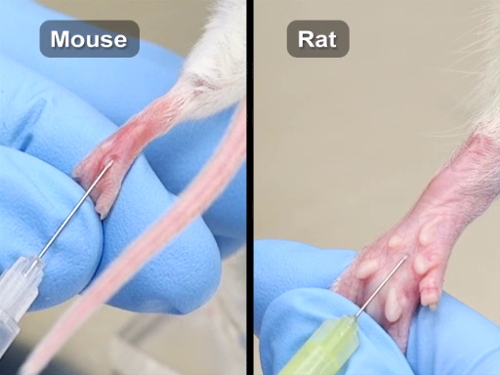화합물 투여 IV
Overview
출처: 케이 스튜어트, RVT, RLATG, CMAR; 발레리 A. 슈뢰더, RVT, RLATG. 노틀담 대학교, IN
실험실 마우스와 쥐에서 화합물 관리를 위한 많은 일반적으로 사용 되는 경로. 프로토콜은, 그러나, 덜 일반적으로 사용되는 경로의 사용을 요구할 수 있습니다: 심내, 발판 및 복고풍 궤도 주사. 이러한 절차를 성공적으로 수행하기 위해서는 전문 교육이 필수적입니다. 이러한 경로에 대한 정당성은 기관 동물 관리 및 사용 위원회 (IACUC) 승인을 얻기 위해 제공 될 수있다.
Principles
내심 투여는 골암 전이의 동물 모델의 발달뿐만 아니라 심근 경색의 결과에 대한 직접 내심 전달의 효과에 대한 검사를 포함하여 다양한 응용 분야에서 사용되어 왔다. 이 절차는 종종 초음파를 사용하여 바늘을 심장의 올바른 위치로 안내합니다. 2 그러나 적절한 랜드마크를 활용하여 올바르게 수행하면 초음파 시각화를 사용하지 않고 이 절차를 수행할 수 있습니다.
절차의 침략적인 특성 때문에, 심내 주입의 사용은 IACUC 프로토콜에서 과학적으로 정당화되어야 합니다. 단 하나의 생존 주사를 허용해야 한다. 이 절차는 조직 내에 규정 된 지침에 따라 일반 마취제, 흡입제 또는 주사용의 사용을 요구합니다. 바늘 선택은 주입된 물질의 점도를 허용할 가능한 가장 작은 크기여야 합니다. 일반적으로 27-30 게이지 바늘이 사용됩니다. 사출 량은 100 μL에서 최대 300 μL까지 다양합니다.
마우스의 꼬리에 있는 정맥 주사는 도전적이고 수시로 실패합니다. 정맥 투여의 대체 경로는 복고풍 궤도 신경총을 통해입니다. 이 기술은 훈련과 능력을 수행해야하는 동안, 연구는 측면 꼬리 정맥 주입보다 복고풍 궤도 주입과 높은 성공률이 있음을 보여 주었다. 3, 4, 5 마취는 절차 도중 마우스가 이동하지 못하도록 하기 위하여 필요합니다. 종병이나 정밀기화기에 부착된 유도 챔버를 통해 전달되는 일반 흡입제 마취가 효과적입니다. 그러나 흡입제가 사용되는 경우, 동물이 챔버에서 제거되면 신속하게 복구되기 시작하므로 주사를 수행 할 준비가되어 있어야합니다. 국소 안과 마취제 (테트라카인 또는 프로파라카인)는 여러 주사를 수행 할 때 권장됩니다.
마우스와 쥐의 궤도 정맥 구조는 다릅니다. 마우스는 주상혈관 정맥, 등갈비 정맥, 열등한 팔페브랄 정맥, 눈 주위 의 궤도 의 공간을 채우는 피상적 측두정맥을 포함한 여러 선박의 부비동 또는 수렴을 가지고 있습니다. 쥐 궤도 지역에는 혈관의 네트워크 나 신경총이 있습니다. 모든 주사와 마찬가지로, 선택한 바늘은 가능한 가장 작은 크기여야합니다. 일반적으로 27-30 게이지 바늘. 더 큰 부피의 보고가 있었지만, 최대 부피는 눈당 150 μL입니다. 3, 4, 5 눈 당 한 주사, 하루에, 권장, 생존 절차에 대 한 눈 당 총 2 회 주사. 또한, 주사 사이 적어도 하루 간격 이 있어야. 비생존 절차의 경우 최대 500 μL의 부피를 투여할 수 있습니다.
논란에도 불구 하 고, 주입 사이트로 발 패드의 사용은 여전히 일부 연구에 대 한 필요. 발 패드를 통해 주입할 때 일부 마우스 균주에서 항체 반응이 호크에 주입될 때보다 현저히 강하다는 것이 입증되었습니다. 6 모든 동물은 통증의 징후, 음식 소비 수준 및 정상적인 앰비저브를 위해 면밀히 모니터링해야합니다. 발의 자가 절단은 다리가 파괴되는 정도까지 발생할 수 있습니다. 이것은 만성 통증의 표시입니다. 자기 절단을 보여주는 모든 동물은 즉시 수의사의 주의를 기울여야합니다.
풋패드 측정은 명백한 붓기가 발생하자마자 매일 수행되어야 합니다. 최종 점수는 IACUC 지침에 따라 제자리에 있어야 합니다. 일반적으로, 병변이나 종양이 음식과 물을 앰플하거나 도달하는 동물의 능력을 방해할 때 동물은 안락사되어야 합니다. 풋패드에 주입할 수 있는 최대 부피는 50 μL입니다. 주사에 29-30 게이지 바늘을 권장 합니다.
Procedure
1. 심내 주입
- 랜드마크 및 포지셔닝: 마우스 또는 쥐를 오른쪽 측면 재조정(왼쪽이 위쪽으로 향함) 또는 등쪽 재조정에 배치하고 랜드마크를 식별합니다.
- 팔꿈치의 포인트와 흉골의 왼쪽에 심혼을 대략 평평하게 배치합니다.
- 팔꿈치 의 지점에서 갈비뼈 사이에 바늘을 삽입합니다.
- 등대 변조에 있는 동물에서 바늘을 식탁과 평행하게 가슴에 삽입합니다.
- 측면 의 복종에 있는 동물에서, 테이블에 수직가슴에 바늘을 삽입합니다.
- 기사의 주입
- 이 심장 기능을 손상으로, 심근 낭에 출혈을 일으키는 원인이 되는 근육을 방지하기 위해 심장에 삽입되면 바늘의 최소한의 움직임이 있는지 확인합니다.
- 주사기를 흡인하여 적절한 배치를 결정합니다. 종종 주사기의 허브에 혈액의 플래시가있다.
- 바늘이 심장에 배치되면 주사주사기에 손이 재배치되지 않도록 주사기를 잡으라.
- 느리고 꾸준한 방식으로 기사를 주입.
- 출혈을 최소화하기 위해 바늘을 천천히 철회하십시오.
- 호흡 곤란, 발작, 청색증, 장기간 운동 실조 또는 주사 외상과 관련된 다른 후유증을 경험하는 마우스는 수의사 직원에 의해 평가되고 그들의 권고에 따라 안락사되어야 합니다.

그림 1. 마우스에서 심장 내 주사.
2. 레트로 궤도 신경총을 활용한 정맥 주사
- 사출 랜드마크 및 포지셔닝
- 동물을 평평한 표면에 놓고 측면 의지에 놓습니다.
- 바늘을 코에 45° 각도로 눈의 내측 캔투스에 삽입합니다.
- 바늘 깊이는 결막 조직을 관통하고 안구 궤도 뒤에 그리고 안구 신경총으로 전진하기에 충분해야 합니다. 바늘을 배치 할 때, 그것은 궤도의 뒷면에 뼈를 발생하지 않아야합니다.
- 턱에 엄지 손가락으로 머리 위에 검지 손가락을 놓습니다.
- 부드럽게 뒤로 아래로 당겨 피부를 조이고 안구를 돌출합니다.
- 기관체에 압력을 가하고 공기 흐름을 제한하지 않도록주의하십시오.
- 주사
- 안구가 아닌 눈 뒤에 바늘을 놓습니다.
- 바늘이 한 번 복고풍 궤도 신경총에 삽입 된 최소한의 움직임을 가지고 있는지 확인, 또는 혈관은 눈 뒤에 조직에 에이전트의 출혈과 손실을 일으키는 파열됩니다. 주사를 잡고 바늘이 복고풍 궤도 신경총에 배치되면 주사를 위해 주사기에 손이 재배치되지 않도록하십시오.
- 당신이 선박을 붕괴할 것이기 때문에 주사기와 흡인하지 마십시오.
- 느리고 꾸준한 방식으로 기사를 주입.
- 바늘을 철회하고 출혈을 제어하고 혈청을 제공하기 위해 눈에 가벼운 압력을 가합니다.
- 부종을 경험하는 마우스, 결막염, 또는 주사 외상과 관련된 그밖 후유증은 수의학 직원에 의해 평가되고 그들의 권고에 따라 취급되거나 안락사되어야 합니다

그림 2. 마우스에서 복고풍 궤도 주입.
3. 풋 패드 주입
- 구속을 위해, 한 개의 뒷발이 분리된 구속 튜브에 동물을 놓고, 피부를 움켜쥐는 것으로 확장합니다.
- 주입하기 전에 이물질을 제거하기 위해 물이나 알코올로 발을 닦으부습니다.
- 주사 부위에 작은 출혈을 형성하는 뒷발의 중심에 피하주사한다. 발의 길이를 실행하는 혈관을 피하려면 혈관과 평행한 중간줄을 막 벗어보세요.

그림 3. 마우스와 쥐에 풋 패드 주입.
Application and Summary
동물로 화합물의 관리 동물의 웰빙과 실험 데이터 및 과학적 가치의 결과 모두에 중요 한 영향을 미칠 수 있습니다. 적절한 전달 방법은 실험의 성공에 필수적입니다. 연구의 과학적 목표, 물질의 pH, 필요한 투여량, 물질의 점도, 동물의 웰빙 등 최상의 경로를 결정하는 데 많은 요소를 고려해야 합니다. 기술 전문 지식은 또한 모든 주입 방법에 대한 요구 사항입니다.
References
- Morton, D.A., Jennings, M., Buckwell, A., Ewbank, R., Godfrey, C., Holgate, B., Inglis, I., James, R., Page, C., Sharman, I., Verschoyle, R., Westall, L., and Wilson, A.B. 2001. Refining procedures for the administration of substances Report of the BVAAWF/FRAME/RSPCA/UFAW Joint Working Group on Refinement. Members of the Joint Working Group on Refinement. Laboratory Animals. 35. 1-41
- Prendiville , T.W., Qing, M., Lin, Z., Zhou, P., He, A., and Pu, W.T. 2014. Ultrasound-guided Transthoracic Intramyocardial Injection in Mice. Journal of Visualized Experiments. 90 | e51566.
- Yardeni, T., Eckhaus, M., Morris, H.D., Huizing, M., and Hoogstraten-Miller, S. 2001. Retro-orbital injection in mice. Lab Animal. 40:5. 155-171.
- Steel, C., Stephens, A., Hahto, S., Singletary, S., Ciavarra, R. 2008. Comparison of the lateral tail vein and the retro-orbital sinus as routes of intravenous drug delivery in a transgenic mouse model. Lab Anim. 37. 26-31.
- Timm, K.I. 1989. Orbital venous anatomy of the Mongolian gerbil, with comparison to the mouse, hamster, and rat. Laboratory Animal Science. 39:3. 262-265.
- Kamala, T. 2007. Hock immunization: a humane alternative to mouse footpad injections. Journal of Immunological Methods. 328. 204-214.
Tags
건너뛰기...
이 컬렉션의 비디오:

Now Playing
화합물 투여 IV
Lab Animal Research
51.7K Views

설치류 취급 및 통제 기술
Lab Animal Research
174.6K Views

실험실 기본 관리
Lab Animal Research
28.0K Views

사육 및 이유의 기초
Lab Animal Research
35.7K Views

설치류 식별 I
Lab Animal Research
54.8K Views

설치류 식별 II
Lab Animal Research
25.6K Views

화합물 투여 I
Lab Animal Research
100.7K Views

화합물 투여 II
Lab Animal Research
34.9K Views

화합물 투여 III
Lab Animal Research
31.5K Views

혈액 채취 I
Lab Animal Research
171.8K Views

혈액 채취 II
Lab Animal Research
73.3K Views

마취 유도 및 유지
Lab Animal Research
50.6K Views

설치류 수술에 대한 고려 사항
Lab Animal Research
22.5K Views

진단 부검 및 조직 수확
Lab Animal Research
58.1K Views

멸균 조직 수확
Lab Animal Research
34.8K Views
Copyright © 2025 MyJoVE Corporation. 판권 소유